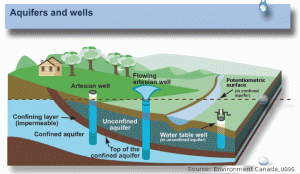
Changes in climate can rapidly impact even the deepest freshwater aquifers according to Penn State and Columbia University hydrologists.
The researchers found that responses to climate variations can be detected in deep groundwater aquifers faster than expected — in many cases within a year.
Because rain water may take years to reach deep aquifers through natural infiltration, the findings suggest another factor is involved, such as pumping of aquifers done by agricultural industries.
“We saw a rapid response in deep groundwater levels to both major climate cycles and local precipitation,” said Tess Russo, R.L. Slingerland Early Career Professor of Geosciences at Penn State. “These aquifers are so deep, we expect it takes years for precipitation to make its way down, so if it’s not natural recharge causing the response of groundwater to changes in precipitation, then it may be coming from pumping changes.”
The research, published in Nature Geoscience, sheds new light on groundwater budgets in the U.S. and better defines how water held in deep aquifers could change with the climate. Groundwater used by municipalities and industry is almost always drawn from deep wells, which provide a more reliable source of water than shallow aquifers, especially during times of drought.
Despite the importance of these deep aquifers, no one really knows how much water they contain or how they might react to climate change.
“Groundwater doesn’t move very fast so we typically think of deep aquifers as having a delayed response to what’s going on at the surface, including our changing climate,” said Russo, who is also an associate in Penn State’s Earth and Environment Systems Institute. “But we actually see a relatively rapid response.”
Russo and Upmanu Lall, of the Columbia Water Center at Columbia University, analyzed relationships between climate and groundwater data from across the United States, and used a small set of regional pumping data from wells in Kansas to demonstrate the potential connection.
Russo said evidence suggests that pumping represents an intermediate connection between precipitation and deep groundwater levels. Changes in temperature and rainfall can affect crop water requirements, for example, leading to changes in reliance on water from deep wells.
“If you look at agricultural areas where you have crop water demand changing as a function of precipitation, that is going to control pumping variability over time,” Russo said. “Pumping could be an intermediate connection between climate and groundwater — one that causes an immediate response.”
Though evidence suggests pumping causes the rapid response between deep groundwater and climate, scientists were not able to conclusively link them because of a lack of pumping data across the U.S.
“We need more data collection on human activities,” Russo said. “We need pumping records if we are really going to nail down the connection between climate and groundwater.”
Note: The above post is reprinted from materials provided by Penn State.










